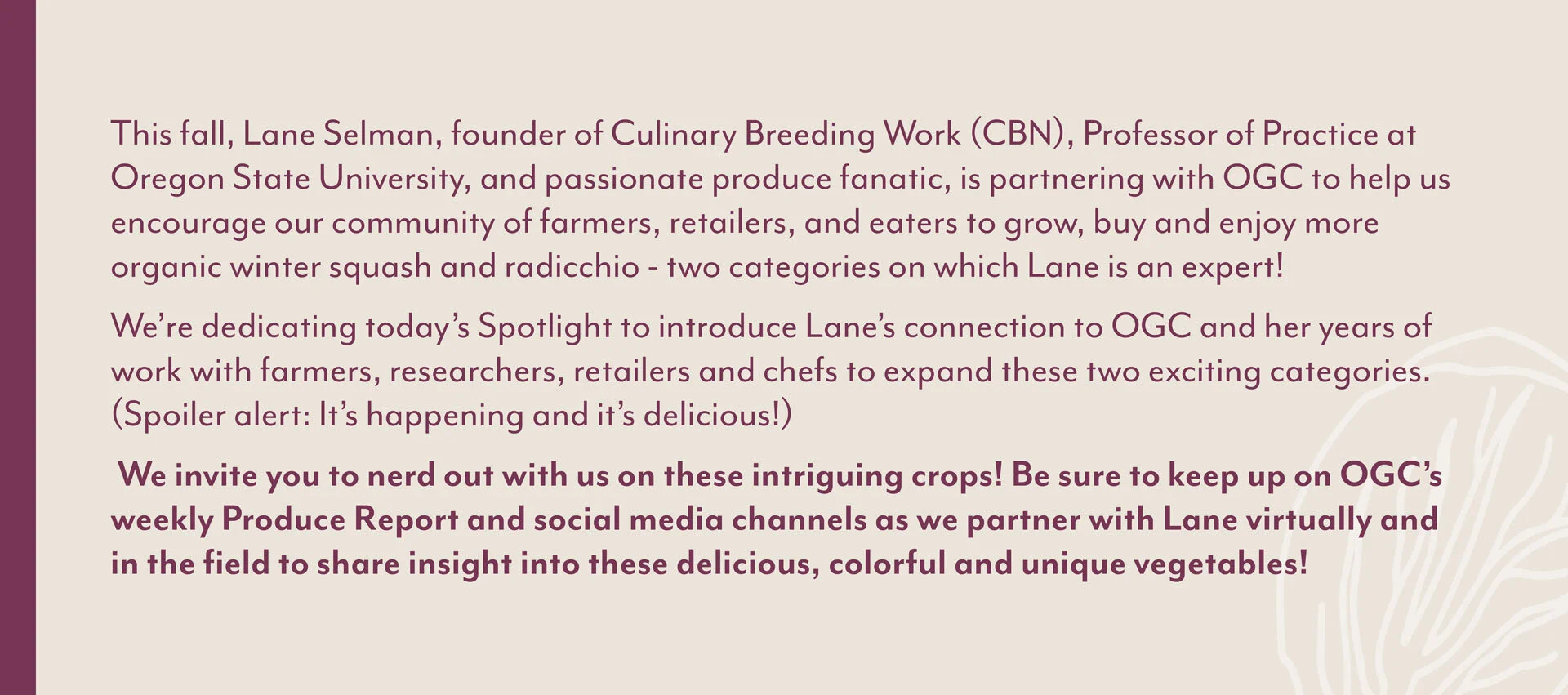OGC’s Friend Lane Selman Wants You to Eat More Winter Squash and Radicchio, Too!
During a trip to Italy, I was inspired by Sagre, which are Italian celebrations of food, vegetables, and locality. There are nearly 30 thousand sagre in Italy annually – each one a proud salute to local traditions, community, and the food that brings people together. So it seemed only fitting to bring the idea back to the U.S.
The first sagra organized by my company, the Culinary Breeding Network (CBN), was in 2017 and part of a project called “Eat Winter Squash.” It was held in Portland and created an opportunity for the community to meet squash varieties that grow and store well (often different than the ones consumers are familiar with) and learn how to cook, process, and enjoy them at their best.
Then, in 2018, the Sagra del Radicchio was born and organized Chicory Week, a Seattle festival led by a grassroots team including CBN, Local Roots Farm, Uprising Seeds, and restaurant partners London Plane and Tom Douglas Restaurants.
The two gatherings sold out, a testament to how quickly winter squash and radicchio were winning over the culinary community, growers and eaters in our region of the world! But despite their cult-like following amongst adventurous foodies, winter squash and radicchio present some challenges that have, so far, kept them more niche. CBN aims to change that!
Getting People to Eat More Winter Squash
Winter squash is nutritious and delicious, yet most eaters don't consume very much of it and are reluctant to experiment with varieties less familiar to them. One reason is that people have limited knowledge about how to cook it - you can only eat so much squash soup! Another reason is that many of us grew up eating (unripe) acorn squash, and that doesn’t taste good.
Working in partnership with OSU’s Vegetable Specialist Alex Stone, CBN created the “Eat More Squash” project in 2015. It started as a response to Oregon farmers lamenting that they weren't making money on winter squash, as so much of it rotted in storage in early fall. It surprised many to learn that here in western Oregon, most of the squash consumed from December through April has historically come from California or Mexico. We thought this was odd, as Oregon has such an ideal climate for growing winter squash.
The “Eat More Squash” project identified squash varieties grown specifically for long storage that could be cultivated in the summer and fall and stored into the winter.
Beyond finding varieties that would store well and yield a better profit for growers, we wanted to be sure that eaters would enjoy them, too. Our partner chef, Timothy Wastell, tasted each variety as they ripened in storage over that first year. And then went through that same process again the next year - and then again the next year.
In all, we identified 13 varieties that passed our rigorous tests. Some like Tetsukabuto, Black Futsu, and Winter Sweet have already begun to make their way into the mainstream. Others, such as the Sunshine, a Kabocha-like squash that’s brilliantly colored with exceptionally smooth flesh, or Silver Bell, a Banana-like squash variety with deliciously sweet and dry flesh, are just waiting to be loved by growers and eaters alike!
More than the project’s interest in the profitability for growers, and new options for eaters, there’s good reason for Americans to eat more squash.
Many nutritionists and experts in agricultural sustainability believe that people should eat plant-forward. Scientists are only recently investigating the nutritional properties of winter squash. Their studies have shown that winter squash is very high in vitamins A and C, antioxidants, and anti-inflammatory agents. Winter squash is substantial and can be eaten as a main course instead of meat. Many varieties can also be eaten raw in salads and can be an exciting addition to desserts.
Squash diversity (in texture, flavor, size, and culinary uses) means that there should be a diversity of strategies for incorporating squash into diets - we just need to cook up some novel uses!
OGC works with Northwest growers to provide eaters with many familiar favorites and some of the long storage varieties that CNB is passionate about.
For a list of what’s available this fall and winter from OGC, click here!
Radicchio is on a Roll
It is 2021, and the culinary world in the United States is (finally!) a couple of years into a burgeoning infatuation with radicchio. This leafy vegetable has yet to reach many U.S. consumers; still, a growing legion of fans rush to buy a head the minute they see a sexy Instagram spread with the frustratedly inaccurate caption “pink lettuce.”
I’ve been working for over a decade to get eaters excited about this striking vegetable. So delicious that my own Italian mother would buy it at the grocery store, which was notable as she grew most of the other vegetables we ate.
I didn’t think a lot about my mother’s radicchio salads growing up, and I certainly didn’t eat them as I was sensitive to their bitterness in my younger years. But around 2012, I started hearing Northwest farmers I work with ask questions about growing this mysterious crop. Would it grow well here? Could we get consumers to eat it? The answer took many years to figure out but is invariably: yes! With a little help from our Italian friends.
In 2014, I visited Italy as a Slow Food Terra Madre delegate. While there, I met with a young aspiring Italian plant breeder from Chioggia, Andrea Ghedina, who worked for T&T Seeds, a highly regarded radicchio seed company. Two Oregon farmers joined me in a quest to learn more about growing radicchio. Of particular interest was the then elusive, 'Rosalba’ pink radicchio, which had not yet become “a thing” in the U.S. and could rarely be found outside of northeast Italy.
Andrea spent a full day with us, visiting radicchio farms and packing houses. She educated us about many of the challenges our American farmers would face. It was a fantastic day, even though I sadly didn’t get to see any pink radicchio.
That trip inspired what has become a true obsession with finding more growers and eaters to fall in love with radicchio in the U.S.
What is radicchio exactly?
Radicchio is a cultivated member of the Chicory family, the wild ancestor of a kind of dandelion that has been harvested and eaten for a millennia. Radicchio is a cool-season vegetable that originated and is still widely grown in the Veneto region of northeastern Italy, a climate with temperatures and latitude very similar to the Pacific Northwest.
It is a promising prospect for Northwest farmers for its ability to overwinter in the field, long storage, and as a locally-grown alternative to lettuce shipped from warmer regions during the colder months. In the U.S., the round, red Chioggia type is the most commonly found variety on grocery store shelves. However, growers are producing a much wider variety of radicchio including Treviso Precoce, Treviso Tardivo, Castelfranco, Lusia, Verona, Rose, Puntarelle and more. Each has a unique appearance, flavor, texture and culinary purpose.
Sometimes bitterness deters eaters from turning to radicchio, but it needn’t. Most radicchio simply needs a quick soak in ice-cold water to tame its bitterness, which still allows its complex flavors to play on the plate.
Salads of radicchio are best paired with round, full-flavored companions like nuts and cheese or zingy acids like vinegar and tangy fruit. It can also be cooked and is particularly tasty when caramelized. High-heat roasting or long, slow braising transforms raw radicchio in the best of ways.
With eaters’ tastes evolving, radicchio will soon join coffee, beer, spicy peppers, and arugula in affording particular pleasures that we crave once we’ve acquired a taste for it. And it’s a delectable way to add vitamins A and C, as well as iron, to a nutritious diet.
In January 2020, just before the pandemic engulfed the world, I organized a Radicchio Expedition for 22 Pacific Northwest farmers, chefs and educators to visit northern Italy to learn more about farming methods and culinary uses for this quintessentially Italian crop. The goal was to bring back that information for growers, cooks, and eaters in the U.S. We have learned a lot since that trip. The hope is to inspire growers, sellers, and consumers to expand their palate for radicchio and increase the varieties grown by farmers in Oregon and Washington.
I hope you join me, OGC and the community of radicchio enthusiasts around the Northwest in celebrating this incredible crop! Paired with winter squash, these two vegetables are ideal for inspiring new ways to enjoy fall and winter eating!
Yours,
Lane Selman





